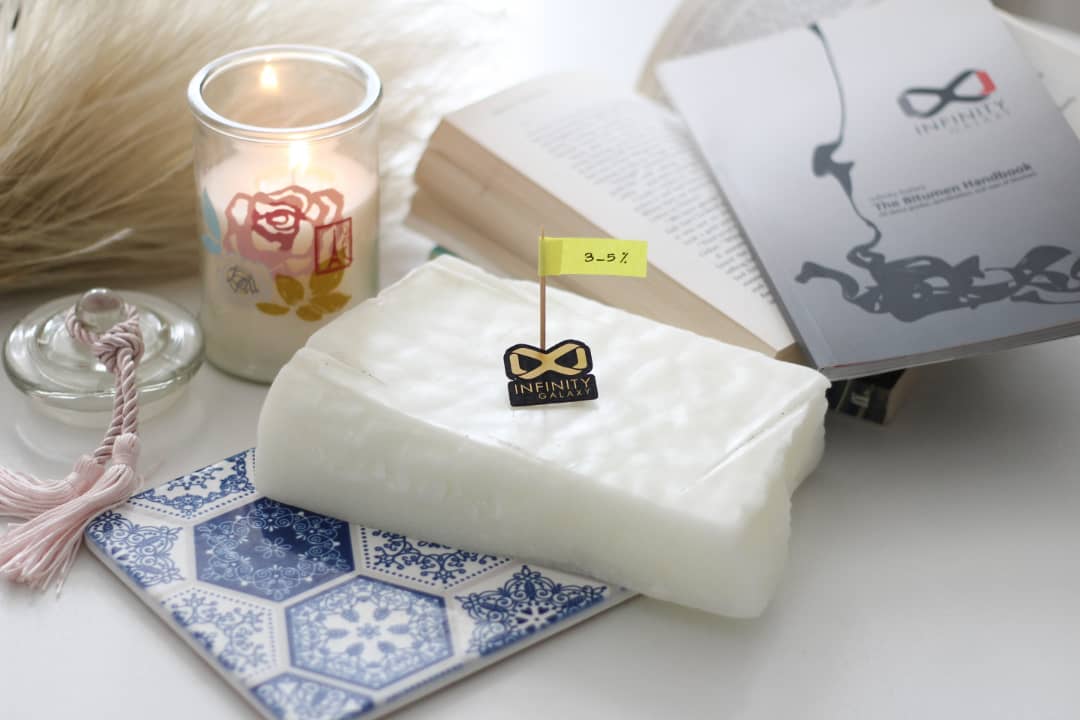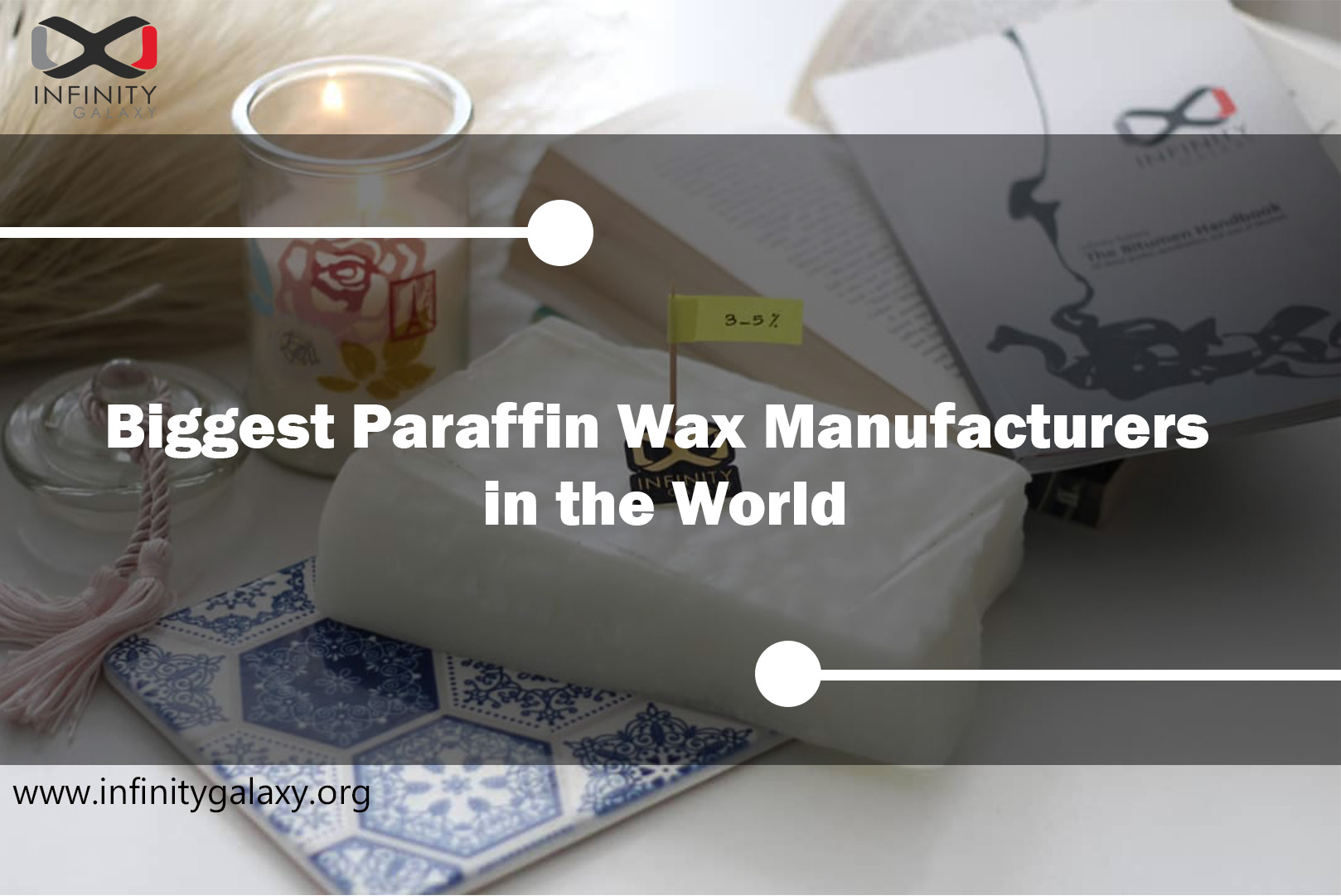What is Paraffin Wax?
Paraffin wax is a crystalline, soft, white, and solid material at room temperature. It can also be a colorless product.
Paraffin wax density is 900 kg/m3. It is a byproduct of the oil refining process. The raw material of paraffin wax is gasoil or kerosene which is obtained from the distillation tower in the oil refinery.
Paraffin wax melts between 40°C and 70°C. All the physical properties of paraffin wax depends on the length of the hydrocarbon chain, the distribution of components like aromatics, and their degree of branching.
Paraffin Wax Chemical Formula
Paraffin wax chemical formula is generalized as CnH2n+2. It consists of a mixture of hydrocarbon molecules containing between 20 and 40 carbon atoms. Different composition influences the wax’s specific properties, such as melting point and hardness.
Where Does Paraffin Wax Come From?
German chemist “Karl Reichenbach” discovered paraffin wax in 1830. It was produced by cracking mineral oil.
Types of Paraffin Wax
Paraffin wax has two types:
- Fully refined paraffin wax
- Semi refined paraffin wax
The difference between them is in the oil content. The oil content of fully-refined paraffin wax is less than semi-refined paraffin wax.
Fully-refined paraffin wax is water-free, odorless, and has a solid structure that cannot be changed easily.
Read a complete article about Paraffin Wax Types and Grades.
Paraffin Wax Application
Candle making:
The most common use of this product is in candle making.
Candle-making paraffin wax is supplied for the production of warmers and all kinds of candles with different quality and oil grades.
Paint making:
In thermal printers, this material is used to make ink.
Thermal and electrical insulation:
Paraffin wax is used in the manufacture of electrical products such as transformers and inductors.
The advantages of using paraffin wax in electrical appliances include preventing moisture from entering them, removing noise from them, and limiting microphonic effects.
Waterproof coatings:
Paraffin wax is used to cover and shine fruits, vegetables, chocolate, and cheese to prevent them from spoiling and to preserve them for a long time.
Building materials:
Paraffin wax is used in building materials such as drywall and PVC pipes.
It protects them from corrosion in the building.
Medical:
This product is used in the histology and pathology laboratory. In pathology, the tissue is placed in paraffin wax before cutting so that it is not damaged.
Also, it is used as a coating for tablets and capsules.
Lubrication:
Paraffin wax is used for the lubrication of machine parts, bicycles, engine chains, and lubricants.
Other uses:
- Matchmaking
- Paper coating
- Rubber making
- Glue making
- Cosmetics
- Hygiene products
Paraffin Wax Advantages
One of the main advantages of paraffin wax is its high thermal stability. It can be used in heat storage due to its high specific heat capacity.
Due to the good resistance of paraffin wax against water, its low water vapor permeability, and its relatively good dielectric strength, it can be used for insulation in electrical appliances.
Paraffin Wax Tests
Paraffin wax tests should be done on paraffin wax to determine the properties of this product. These tests are based on the international standard test methods of ASTM.
Melting Point Test
ASTM D87 (Standard Test Method for Melting Point of Paraffin Wax)
The melting point is the temperature at which a solid paraffin wax turns into liquid.
The melting point of paraffin wax depends on its molecular weight. It means that when it has a higher molecular weight, its melting point increases.
In this method, the paraffin wax should become liquid by heating. The liquid paraffin wax sample is placed in a test tube fitted with a thermometer. Then it should be placed in an air bath.
As the liquid paraffin wax cools, the temperature should be recorded repeatedly.
Generally, the type of paraffin wax and its quality are determined by its melting point which is obtained by the ASTM D87 test method.
Flash Point Test
ASTM D92 (Standard Test Method for Flash Point of Paraffin Wax)
The flash point is the temperature at which paraffin wax can ignite. By this method, the flash point of a sample is determined.
In this test, paraffin wax is placed in the cup. The temperature rises quickly at first and then slowly. Then a flame is passed over the top of the cup. The lowest temperature at which paraffin wax vapors ignite is the paraffin wax flash point.
Congealing Point Test
ASTM D938 (Standard Test Method for Congealing Point of Paraffin Wax)
Congealing Point is the temperature at which paraffin wax does not flow. This test can indicate the purity of the paraffin wax.
In this test, a thermometer is placed in the paraffin wax sample. Then the thermometer rotates slowly in the air along with the paraffin wax cover. The Congealing point is the temperature at which paraffin wax freezes.
Oil Content Test
ASTM D721 (Standard Test Method for Oil Content of Paraffin Wax)
This test is used to determine the amount of oil content in paraffin wax.
The devices required to perform this test include filter stick and assembly, cooling bath, and Evaporation Assembly.
To perform this test, paraffin wax is first dissolved in methyl ethyl ketone. The solution is cooled to -32°C until precipitation is formed. The sediment is filtered and the residue is weighed. Oil and solvent are removed. Then the solvent is evaporated to determine the weighable amount of oil.
Penetration Test
ASTM D1321 (Standard Test Method for Penetration Degree of Paraffin Wax)
The method is to measure the hardness of the paraffin wax.
The sample is heated to a certain temperature, then it is cooled. The sample is placed under the penetrometer needle. The depth of penetration in tenths of millimeters is reported as the test value.
This test shows whether this product is suitable for producing the desired properties or not.
Viscosity Test
ASTM D445 (Standard Test Method for Kinematic Viscosity of Paraffin Wax)
A viscosity test should be done on paraffin wax to obtain optimal storage and handling conditions.
When the liquid paraffin wax flows at a constant volume through the capillary, the time should be recorded. This time should be multiplied by the calibration factor to obtain the viscosity of paraffin wax.
Density Test
ASTM D1298 (Standard Test Method for Density, Relative Density, or API Gravity of Paraffin Wax)
Another important characteristic of paraffin wax is density. A hydrometer, pycnometer, or a more modern digital densitometer is usually used to determine density or specific gravity.
In this test, the temperature of paraffin wax rises to a specific temperature. A suitable hydrometer is lowered into the sample. The sample is settled and after reaching the temperature equilibrium, the scale of the hydrometer and the temperature of the sample are recorded.
Odor Test
ASTM D1833 (Standard Test Method for Odor of Paraffin Wax)
The odor test is another important test of paraffin wax. Since this material is used in cosmetics and food packing, it is essential to check its odor intensity by this test.
In this method, 10 grams of paraffin wax is shaved and placed in an odorless glass bottle with its lid closed.
After 15 minutes, the sample is assessed in an odorless room by removing the cap gently. A score of 0 (no odor) to 4 (very strong odor) is given by each person taking the test.
The reported value is the average of the group member’s scores.
Color Test
ASTM D156 (Standard Test Method for Saybolt Color of Paraffin Wax)
One of the qualitative characteristics of paraffin wax is color, which indicates the degree of refinement of the material.
The test device includes a light source, two glass tubes (for the sample and testing), and a heater.
In this method, a paraffin wax sample is placed in a graduated glass tube. The heater warms paraffin wax. Sample color is compared with standard color discs. If the color of the sample is higher than the color of the disk, the valve is opened to reduce the amount of sample.
Then the color of the sample becomes lighter than the color of the disk. The height of the graduated column is read and its corresponding color is noted. A number higher than the obtained color is the sample color number.
The color of paraffin wax is clear. If its color changes, it shows there exists contamination in it.
However, color is not a very accurate indicator of product quality.
To understand this test better, click on the below link to see the steps:
Paraffin Wax Storage
Paraffin wax is generally stable, but it should be kept at a temperature below 40°C and in a closed container. The reason is that repeated melting and freezing of paraffin wax may change its physical properties.
Oxidation is one of the reactions that happen in the case of improper storage of paraffin wax, which will have a bad effect on the performance of this product. These reactions reduce the lifespan of the paraffin wax.
Materials such as copper, brass, and their respective alloys should not be used in the tanks for storing and moving paraffin wax, because in this case there is a possibility of an oxidative catalytic effect on the paraffin wax.
Storage tanks should be kept away from flames and open electrical coils.
Paraffin Wax Handling
When handling paraffin wax, you should pay attention to some points :
- Be sure to use respiratory protection when working with molten or hot materials.
- Do not let the molten material come into contact with your skin.
- In the liquid state, paraffin wax in high amounts can accumulate static electricity and cause sparks leading to combustion.
Paraffin Wax Safety
However, paraffin wax does not pose any danger to people who deal with it in the short term, but long exposure to it will cause adverse effects on human health including:
- Prolonged inhalation of aerosolized paraffin wax causes lung damage.
- Significant oral consumption of paraffin wax is caused intestinal obstruction in humans.
- It may cause skin problems such as chronic dermatitis and papules
We hope this article provides the information you needed about paraffin wax. If you have further questions or inquiry, please don’t hesitate to contact us.








